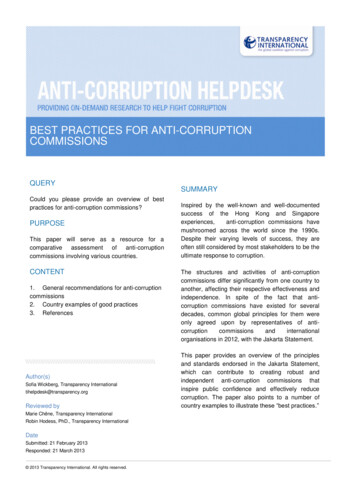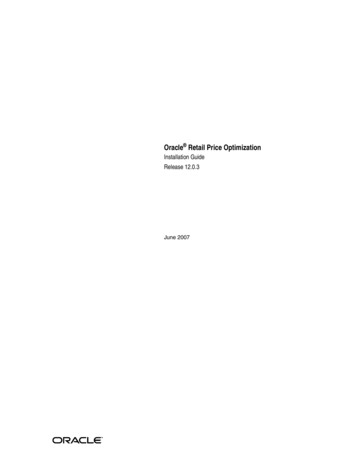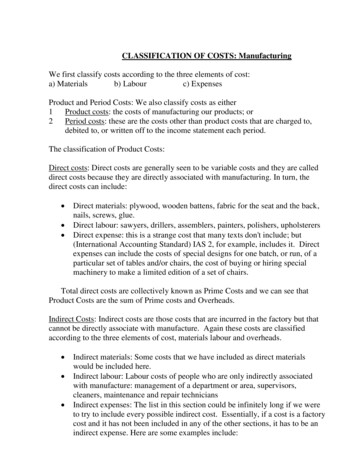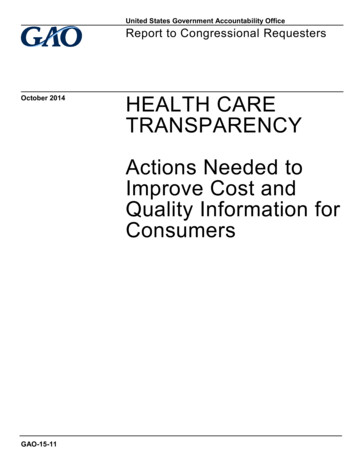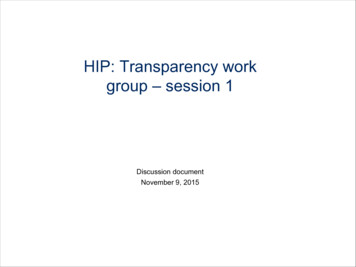
Transcription
HIP: Transparency workgroup – session 1Discussion documentNovember 9, 2015
November 9th Agenda: Price and Quality TransparencyWork group 1TimeSession descriptionSession type9:00-9:30Introduction and goals ofthe work groupPresentation9:30-10:10Price and qualitytransparency innovationinitiativesPresentation cy focus areaexercise11:20-11:30Break11:30-11:50Stakeholder input and fullgroup debriefFull groupdiscussion11:50-12:00Closing and next stepsPresentationBreakout groups 2
Goal of work group session 1 is to provide input and align on principlesPurpose/principles Gather input from multiple stakeholders with the objective of building a plan with thehighest likelihood of success Collaborate with stakeholders across the State to align around a set of guiding principlesShare informed view of what initiatives are happening across the countrySession 1Provide input and align on principlesSession 2Test preliminary strategySession 3Refine strategy and identify interdependencies across broader plan 3
Work group charter: Price and Quality TransparencyWork group title: Price and Quality TransparencyChair: Commissioner MillerProblem statement: Insufficient transparency for consumers, professionals, providers, payers, policy makers leads to inefficient decision making anduncertainty Stakeholders collect large amounts of data, which could benefit all stakeholders, but it is either not accessible or not interpretable There is a growing need to leverage data in a meaningful way to improve transparency focus areas, driven by:– Increasing demand from healthcare consumers to understand quality and out-of-pocket cost of care options due to both––increased consumer cost sharing and a growing healthcare “shopping” cultureShifting focus on value vs. volume leading to a need for providers to understand performance due to greater provideraccountability for outcomes/health and total cost of careGrowing requirement for payers and policymakers to access a high level of data to effectively understand market dynamicsMandate for this group:Types of decisions to provide input on for HIP Plan: Determine which transparency focus areas are most critical to support the goals of PA and shouldbe highest priority Design high-level transparency strategy andrecommend state-led or multi-stakeholder levers toreach these goalsTransparency focus area prioritizationInvestments required to improve transparency focus areasTechnology and mediums to share data across and with stakeholdersAreas where state-wide, regional, local alignment is needed to improvetransparency Areas where the state should play the role of “actor” vs. “catalyzer”Participation expectations: Join 3, 2-3hr work group meetings between now and HIP Plan submission (May 2016)– Webinar (Nov 5th, 2015)– Kickoff (Nov 9th, 2015)– Review / input on draft model design options (Jan, 2016)– Review / input on full draft of HIP Plan (Mar, 2016) Potential ad hoc additional meetings Communicate updates from work group within your organization and collect feedback to share back 4
Milestones for HIPJulyStakeholderengagementkickoff at NGAQ3Nov Webinar briefingfor work groupmembers Work GroupsSession 1: InputJanCatalyst forPayment Reformpayer surveyQ4MarchWork GroupsSession 3:RefineQ12015Q2MaySubmit HIP planto CMMIQ32016Dec / early JanWork GroupsSession 2: TestEnd of Jan / FebDraft (outline) offull HIP plancompleteSummerLaunch paymentmodel accordingto implementationplan 5
Price and quality transparency end state vision and objectivesPerformance transparency“Shoppable” care transparency Patients, providers, employers, andother stakeholders have clearunderstanding of cost and qualityperformancePatients are empowered, enabled, andincented to make value-consciousdecisions around their care choicesRewarding valueConsumer behavior change Level of transparency enables theimplementation of innovative paymentmodels to reward providers fordelivering patient outcomes and costeffectivenessConsumers are able to understand theimpact of their behaviors on their ownpersonal healthCommonwealth plays different roles to achieve objectives: Catalyzer of health care change for allActor via actions that improve state-run programs 6
November 9th Agenda: Price and Quality TransparencyWork group 1TimeSession descriptionSession type9:00-9:30Introduction and goals ofthe work groupPresentation9:30-10:10Price and qualitytransparency innovationinitiativesPresentation cy focus areaexercise11:20-11:30Break11:30-11:50Stakeholder input and fullgroup debriefFull groupdiscussion11:50-12:00Closing and next stepsPresentationBreakout groups 7
Price and quality transparency needs differ by data user Data userHigh-level use caseExamples Access meaningfuldata to informpersonal healthrelated decisions Make an informed choice about health plansSelect a physician or care facility for a requiredhealth procedure based on price, quality,safety, etc. Deliver effectivecare to patients Select the right referral pathway for a patient,comparing specialists on price, quality, etc.Track and analyze own performance on coremeasures Access marketintelligence toinform contractnegotiations Compare performance of different providers and/or facilities when deciding on network structure,negotiating contracts, making acquisitions, etc. Inform policy designand evaluate policyimpact Evaluate implementation of the HIP and impact:– Progress towards APC– VBP penetration– Provider performance against core measuresConsumerProviderPayerPolicy maker 8
and span focus areas across consumer health, provider care, and payerinformationFocus areasConsumer healthHealth literacy Description Examples Provider careSelf-care / selfmonitor dataUnderstandinghealth caredelivery andsystemsAwareness ofrights Types of healthcare deliverymodelsavailable (e.g.,urgent care,telehealth, ED)Stakeholderrights (e.g.,patient,provider, payer) Primary careAccess topersonal healthrecordsQuantifiedhealth careconsumerthrough selfmonitoring Personalelectronicmedical recordaccessibilityPersonal healthbehaviormonitoring(e.g., Fitbit,Apple health) Payer information“Shoppable”care episodes,commoditiesRegularmedical careadministeredby a primarycare provider Care for basichealth needsReferrals todownstreamcare entand prevention “Nonshoppable”care episodes,inpatientPlan designPayment /claimsCare that is“shoppable” atthe point-ofsale; orCare that is notlessdifferentiatedon quality Care that is not“shoppable” atthe point-ofsale (or point ofreferral) Healthinsurancecoveragestructure andunderlying plandesign Payer claimsand paymentinformation andoperatingstructureElective or timeinsensitiveprocedures(e.g., hipreplacement)Imagingdiagnostics(e.g., MRIscan) Complex careneeds that aretime sensitive(e.g., heartattack, stroke)Overnight staysin a hospital forvarious careneeds (e.g.,observationdays posthealth event) Communicationof informationon coveragestructure / plandesign acrossplans (e.g.,deductible,networkstructure) State-widepopulationhealth analysesbased onanalysis ofaggregatedclaims Focus areas consider both price and quality transparency 9
Select examples of price and quality transparency initiativesXCase examplesFocus areasConsumer healthHealthliteracyData userConsumerSelf-care eProvider careOtherPrimary careMA: providers arerequired to givecost informationto requestingpatientsPayer : payers arerequired to providecost, qualitycomparison tools onwebsites and mobilePlan designPayment /claimsOtherACA marketplaceguidelinesand ompareprovidesuser-friendlyaccess to thestate’s APCDdataOH: plan to supportprovider performanceimprovement throughmulti-payer reportsand accelerate dataintegration effortsPolicymaker 10
1 Nationally, test providers share visit notes with their patients throughthe OpenNotes initiativeStart date: 2010Number of providers: 100s of national test sites including allU.S. VA Medical Centers nationwideInitiative status: OngoingNumber of patients/members: More than 5 millionGoals Empower patients to take control of their health by making visit notes written by their providers available to the patient Develop partnerships between patients and providers by giving everyone on the medical team, including the patient, access to thesame informationApproachResults/impact Patients can view their clinician‘s notes through either patient Patients accessing doctor’s notes say it helped them:– Notice errors in their records– Recall more of what happened during office visits– Remember to follow-up on important appointmentsportals (often used in conjunction with EHR systems) or via mailtyped or hand-written notes Participating providers will make key decisions about participation,including– For what types of care notes will be available (e.g., outpatientonly)– Whether a provider can exclude a patient from the program– Whether the provider can see if the patient has read a note– Whether particular notes can be hidden from the patient (forsensitivity reasons) OpenNotes is funded by the Robert Wood Johnson Foundationand was originally established in 2010 at three test sites:Geisinger Health System, MD Anderson Cancer Center, and BethIsrael Deaconess Medical Centerand take their medication 92% of patients opened their visit notes 60% of patients reported doing better with takingmedications as prescribed because of OpenNotes 77% of patients reported OpenNotes made them feelmore in control of their care 86% of patients believe OpenNotes would be animportant factor in choosing a future doctor or plan Fewer than 20% of doctors reported taking more timeLessons for PA Simple transparency solutions can have great impact on improving health and health care delivery Initial objections to increased transparency can be handled through demonstrating tangible benefits from increased transparencythrough test pilots and enabling leading stakeholders to drive innovationSOURCE: Myopennotes.org; iHealthBeat study: OpenNotes Initiative Boosts Patent Engagement, Safety 11
2 Ohio will develop a suite of reports to support provider performanceimprovement and accelerate data integration effortsStart date: 2015Number of providers: Full stateInitiative status: PendingNumber of patients/members: Full stateGoals Design and deliver multi-payer data/reports with actionable performance data and data about other providers to Primary Accountable Providers (PAPs), Patient-Centered Medical Homes (PCMHs), and key participating providersAccelerate data integration efforts, expand data access across stakeholders, and create potential for other parties to add data over timeApproachResults/impact Develop a suite of multi-payer reports, using data the state has readily accessible, to Although it is too early tomeaningfully improve provider performance––Provide new cuts of data to PCP/specialists, both within and beyond SIM reporting–Share reports with PCPs/specialists on quality and cost of care facility performanceShare analyses with PCPs to help assess the cost and quality of specialists withina given radius and their referral patternsevaluate Ohio’s price and qualitytransparency initiatives, the statehas established preliminarytargets, including:–Reporting: issue cuttingedge reports within 1 year;gain recognition for reportsthat improve providerperformance within 2 years–Data integration: delivertangible benefits over thenext two years throughfocused Enterprise DataWarehouse efforts Accelerate efforts to integrate data sets:– Focus Enterprise Data Warehouse efforts on high-value use cases that will delivertangible benefits over the next 2 years–Expand access to data across state agencies and external stakeholders (e.g.,researchers, providers)–Integrate Medicare data into the Enterprise Data Warehouse and enable commercialpayers and providers to also contribute dataLessons for PA Price and quality transparency does not necessarily require direct mandates and legislation A use-case approach can help determine opportunities for improvement, especially for technologySOURCE: Ohio state innovation model; Ohio Department of Health 12
3 Massachusetts enacted legislation requiring providers to give costinformation to requesting patientsStart date: January 1, 2014Number of providers: Full stateInitiative status: OngoingNumber of patients/members: Full stateGoals Improve health care quality while reducing cost through increased price transparency as part of sweeping payment reformlegislation passed in August 2012 Expand patient access to medical cost information and empower patients to comparison-shop for careApproachResults/impact Providers must disclose allowed amount or charge of anadmission, procedure, or service within two working days Providers must give patients or insurers directly anyinformation (including CPT codes) that the insurer needs tocalculate out-of-pocket costs for the patient and are required tocooperate with plan’s requests for further information in atimely manner Patients should also be given the phone number of the facility’sbilling office, which may be able to provide additionalinformation about facility costsAccording to a pioneer institute study, eighteenmonths after the effective date the “MA healthcareprice transparency law is still not a reality”– Staff in only 9 of 23 ophthalmology practices knewabout the law– Only 13 of 25 gastroenterology practices whenasked about “routine screening” colonoscopyprovided the cost of all fees within the allowed twobusiness days– “The burdens of obtaining prices falldisproportionately on consumers” Some health systems, like Atrius Health, however,have developed tools to give providers easy access totheir own charges and patient out-of-pocket costsLessons for PA Legislation, however useful by itself, is not sufficient in ensuring compliance from providers and payers Consumers are often unaware of their rights and can have difficulty understanding health care data without access toeasy-to-use toolsSOURCE: Pioneer Institute: Mass. Healthcare Price Transparency Law Still Not a Reality; MassachusettsMedical Society: Massachusetts Medical Price Transparency Law Rolls out 13
4 Washington state required payers to provide cost and qualitycomparison tools on their websites and through mobile applicationsStart date: January 1, 2016Number of providers: Full stateInitiative status: PendingNumber of patients/members: Full stateGoals Ensure that health care consumers have access to cost and quality comparison tools through their insurance company websitesas well as mobile applicationsApproachResults/impact Insurance companies are required to provide a cost and qualitycomparison tool on their website’s homepages as well asthrough a mobile application by January 1, 2016 Given the effective date of the legislation is not untilJanuary 1, 2016, it is much too early for data onconsumer utilization and impact on medical trend– Payers can build on any existing comparison tools that In April 2015, Washington passed a bill to establish afully functional All-Payer Claims Database (APCD) tofurther increase price transparency with widespreadbipartisan support Alignment of the Coalition for Health Care CostTransparency, a broad coalition of business leaders,health care providers, community groups andconsumers across Washington, helped enable thepassing of new legislationthey have already developed Transparency tools are required to provide:– Cost data for common treatments (inpatient treatments,outpatient treatments, diagnostic tests, office visits) as wellas out-of-pocket costs (conditional on plan specifics)– Quality metrics by provider (where available)– Patient review option for members to provide ratings orfeedback– Additional informationLessons for PA Innovation, where possible, should build off existing capabilities Alignment across major health care stakeholders can help enable reformSOURCE: Washington State website; Catalyst for Payment Reform 14
5 Colorado Medical Price Compare provides user-friendly access to thestate’s APCD dataStart date: July, 2014Number of providers: Full stateInitiative status: OngoingNumber of patients/members: Full stateGoals Provide consumers a tool to use objective information to inform health care purchasing decisions Enable providers and facilities to more accurately benchmark their own performanceApproachResults/impact Colorado Medical Price Compare (www.comedprice.org) is apublically available website that displays comparative price andquality information for health care services across Colorado Price information is derived from the legislatively mandatedColorado All Payer Claims Database (APCD)In addition to consumer use and basic reporting, usershave made customized data requests to improvehealth coverage / rate setting, outcome / costimprovement, and payment reform / bundledpayments The tool shows the median price payers and patients pay forspecific services at specific facilities, a cost calculator toestimate patient out-of-pocket costs, and information on quality Initial launch displays price and quality information for hospitalbased services: knee replacement, hip replacement,uncomplicated vaginal birth, cesarean birth (ambulatorysurgery centers and additional services to be added)Data on consumer utilization and impact on medicaltrend is not currently available, however, anecdotalevidence from users suggests excitement aboutthe tool The tool also provides reporting information on key metrics,such as total cost of care, ER visits, Diabetes prevalence, etcColorado Medical Price Compare tool has faced somedelays in terms of adding additional facility types andservices (e.g., ambulatory surgery centers will beadded in 2016, but were originally planned for the endof 2014)Lessons for PA Easy-to-use, consumer friendly tools are a significant factor in ensuring a positive user experience Ramping up price and quality transparency tools can be challenging and lead to potential delaysSOURCE: Colorado Medical Price Compare (www.comedprice.org) 15
Summary: price and quality transparency case studiesExample1DescriptionLessons for PA Test providers share visit notes with theirpatients through the OpenNotes initiative Develop reporting mechanism to shareuseful payer data to help providersimproveIntegrate data to improve usability andaccess of existing data across users Enacted legislation requiring providers toprovide cost information to requestingpatients Requires payers to provide cost andquality comparison tools on theirwebsites and through mobile applications Developed Colorado Medical PriceCompare to provide user-friendly accessto the state’s APCD data OpenNotes(national) 2 Ohio 3 Massachusetts 4 Washington 5 Colorado Simple transparency solutions can have great impacton improving health and health care deliveryInitial objections to increased transparency can behandled through demonstrating tangible benefits fromincreased transparency through test pilots andenabling leading stakeholders to drive innovationPrice and quality transparency does not necessarilyrequire direct mandates and legislationA use-case approach can help determineopportunities for improvement, especially fortechnologyLegislation by itself is not sufficient in ensuringcompliance from providers and payersConsumers are often unaware of their rights and canhave difficulty understanding health care data withoutaccess to easy-to-use toolsInnovation, where possible, should build off existingcapabilitiesAlignment across major health care stakeholders canhelp enable reformEasy-to-use, consumer friendly tools are a significantfactor in ensuring a positive user experienceRamping up price and quality transparency tools canbe technically challenging and lead to delaysAny questions? 16
November 9th Agenda: Price and Quality TransparencyWork group 1TimeSession descriptionSession type9:00-9:30Introduction and goals ofthe work groupPresentation9:30-10:10Price and qualitytransparency innovationinitiativesPresentation cy focus areaexercise11:20-11:30Break11:30-11:50Stakeholder input and fullgroup debriefFull groupdiscussion11:50-12:00Closing and next stepsPresentationBreakout groups 17
Price and quality transparency focus area exerciseFocus areasConsumer healthProvider rimary carePayer “Nonshoppable”careepisodes,inpatientOtherPlan designPayment /claimsOtherData userConsumerExercise directions:§Join your group’s poster and take some post-its§For each focus area (and across focus areas, if applicable)§ Write down opportunities for innovation that are relevant to your assigneddata user group§ Prioritize the opportunities identified by potential impact (high to low)§ Identify the most significant challenges to achieving the desired level oftransparency§At the end of the exercise, one member from each group will present the groupsfindings to the rest of the work groupProviderPayerPolicymaker 18
November 9th Agenda: Price and Quality TransparencyWork group 1TimeSession descriptionSession type9:00-9:30Introduction and goals ofthe work groupPresentation9:30-10:10Price and qualitytransparency innovationinitiativesPresentation cy focus areaexercise11:20-11:30Break11:30-11:50Stakeholder input and fullgroup debriefFull groupdiscussion11:50-12:00Closing and next stepsPresentationBreakout groups 19
Debrief and discussion What surprised / excited you from your discussions on priceand quality transparency? What were the largest opportunities that you identified forprice and quality transparency innovation in PA? What werethe most significant challenges / barriers? Which innovations should be highest priority for price andquality transparency across data users and focus areas? Which innovations should be state-led? Which could be stateinfluenced? Which require multi-stakeholder collaboration? 20
November 9th Agenda: Price and Quality TransparencyWork group 1TimeSession descriptionSession type9:00-9:30Introduction and goals ofthe work groupPresentation9:30-10:10Price and qualitytransparency innovationinitiativesPresentation cy focus areaexercise11:20-11:30Break11:30-11:50Stakeholder input and fullgroup debriefFull groupdiscussion11:50-12:00Closing and next stepsPresentationBreakout groups 21
Next steps Participate in follow-up webinars / callsMeet in January for work group session 2 to testpreliminary strategic planContinue to provide input on price and qualitytransparency innovation strategic plan; preliminarydraft to be shared prior to work group session 2Questions 22
November 9th Agenda: Price and Quality Transparency Work group 1 9:00-9:30 9:30-10:10 10:10-10:20 10:20-11:20 11:20-11:30 11:30-11:50 11:50-12:00 Session description Introduction and goals of the work group Price and quality transparency innovation initiatives Break Transparency focus area exercise Break Stakeholder input and full group debrief


